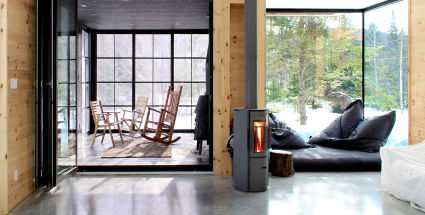
Building an extension, putting up a conservatory… When you add space to your home, that’s another room you need to heat in winter! What solutions are available to guarantee a comfortable temperature in your new space, without spending a fortune (or damaging the planet)?
The architecture, design and choice of materials for the new space are key when it comes to making it comfortable. Indeed, depending on the orientation of an extension, as well as the amount of glass used, the new room may or may not be able to make the most of the most natural and economical source of heating there is: the sun. The ideal solution is to get the most out of it!
But it all depends on what this new space is to be used for as well. Will it be a bedroom or a living area? An occasional room (that can be shut off by closing a door) or one that is used all the time (destined to stay open to the rest of the home)? As you can see, before rushing in to connect an extension to the house’s central heating system, it’s a good idea to ask yourself a few questions first.
Most importantly, to avoid dismissing certain options or having to redo certain aspects of the work (and building an extension is already an expensive job!), it’s best to incorporate your choice of heating solution into the design of the space. For example, make room for a flue if you plan to install a stove...
There are two types of solution: connect the new space to the house’s central heating system, or install an independent, additional heating device, like a wood, pellet or gas stove. Although the first option is totally feasible, the second offers some not insignificant benefits:
The room is only heated when you want to spend time in there, as the heat quickly spreads after the fire is lit. When not in use, the ideal option would be to shut it off to isolate the space from the rest of the house. Also, there’s no increase in your energy bill to worry about .
As long as you choose a modern fire of course! At Stûv, our wood, pellet and gas stoves are all efficient enough to meet the requirements of the Ecodesign 2022 standard, established thanks to a European regulation encouraging products with environmentally friendly designs.
The heat produced by a stove is much nicer than that of a radiator: it is softer, more natural and more focused. The atmosphere created is therefore unlike anything else.
This is an important point when you decide to extend your home: interior design. A stove boasts the huge advantage of being an integral part of the architecture of the extension, the layout of the space and the style of the room. Stûv can even install customised exposed flues, for an even more contemporary visual effect.
A wood-burning stove creates an unparalleled atmosphere in terms of sounds, smells, sensations... So it’s perfect for a room dedicated to relaxation, like a conservatory. And while you’re at it, you can even use it to cook up a storm thanks to the barbecue kit!
A pellet-burning stove yes, but only if it’s quiet! That is the case for the Stûv P-10, which also has the advantage of being really efficient, having a fantastic range (10 hours of heating at maximum power) and a programming option.